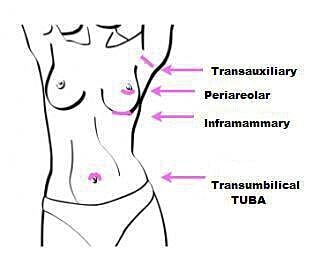There are a number of different incisions used regarding breast
augmentation. They all have advantages and disadvantages. With the recent
FDA approval of silicone implants, the use of each incision has changed
because most women want silicone implants, which do offer a superior look
and feel. There are four approaches to placement of a breast implant:
-
Inframammary This approach involves an incision in the
crease between the chest and breast. This is the most common approach used
for breast augmentation in the nation as it allows excellent control of
the breast pocket with a very well hidden scar. I use this approach
commonly in patients who have a well developed inframammary fold.
-
Periareolar This approach makes an incision at the border
of the nipple and the skin. This incision is best for women with pale skin
and a “salmon” colored nipple. This incision is well hidden when placed at
the appropriate level. I tend to avoid this incision, however, as it is
COMPLETELY VISIBLE TO THE PATIENT. This is the only incision which I get
complaints about. Because of that, I tend not to advocated this approach.
-
Endoscopic-Assisted Transaxillary approach I can place a
saline or silicone prosthesis WITHOUT ANY INCISION ON THE BREAST!!. With
the endoscope, I have complete surgical control and can create any size
pocket necessary. This is the most advanced and difficult technique in
breast augmentation. I use it routinely when women want to avoid incisions
on the breast.
-
Umbilical Approach (TUBA) I do not use this approach.
Having said that, it is a very acceptable approach to breast augmentation.
The problem with it is that you can only use a saline implant. The
overwhelming majority of my patients receive silicone implants because it
is a superior product. If you are interested in a saline augmentation,
consider this approach. Otherwise, avoid it.
Silicone implants come prefilled. Because of this, the incision size can
vary depending upon how large you want to be. This is another reason why the
periareolar incision can be dangerous. If you have a smaller sized nipple,
and you are looking for a greater than 300cc implant, it is very likely that
you will run into problems with your scar. Hiding the incision beneath the
breast obviates the different scar size, as does placing it in the armpit
with an endoscope.
![Breast Augmentation – Approaches to enhancement
[.subhead]Ocean Drive Plastic Surgery</span>](/_static_/blog/breast-aug-890x425-1.jpg)













